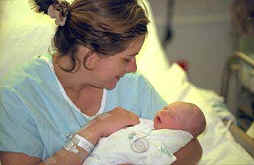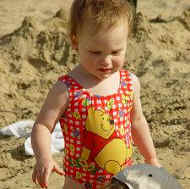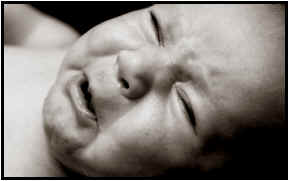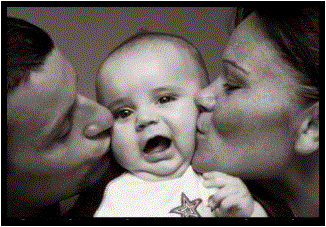
Erik Erikson and Psychosocial Development
stages.
In his theory, eight stages of development unfold
as
we go through the life span. Each
stage consists of
problems
we must face. These problems are believed to be
turning
points of increased vulnerability and enhanced potential.
The
more the person resolves their problem successfully, the
healthier developed they are.
Trust
vs. Mistrust
is Eriksonís first
psychological
a
newborn requires a feeling of physical comfort and minimal
Autonomy vs. Shame is Eriksonís second stage of development, this occurs in late infancy and toddler hood. After gaining
trust in their peers, infants begin to discover their own actions. They star to assert them selves as an independent. If infants are
restrained
from doing so they may develop a sense of shame and doubt.
Aspects of the Psychosocial Domain
Emotions
Newborns:
*The
1st emotion that can discerned with a newborn is
*They
gradually acquire the capacity to cope with or manage
emotionally arousing situations.
*A
social smile occurs about six weeks of age.
*Emotional
responses become increasingly immediate.
*Babies
will cry at first, due to over excitation of the nervous
*Newborns
are pre-adapted to respond to facial stimuli, speech
 Infants:
Infants:
*can recall
past events, anticipate outcome, and behave intentionally.
*An infants emotional reactions respond to events with particular meanings.
*Infants will notice events caused by their behaviors and repeat
these behaviors if the outcome is positive.
*They
tend to have an inclination to fall in step with their caregiverís behaviors.
7 to 10
Months:
Stranger Distress-
Babies react negatively to
strangers.
8
to 9 Months:
Separation Anxiety-
A child is fearful of being
left by the caregiver.
10 to 14 Months: Stranger Wariness- Fear of unfamiliar people.
Personality
|
|
Learning Theory: a newborns personality is molded as parents reinforce or punish their childís various spontaneous behaviors.
 Temperament:
refers
to an infantís general style of behavior.
Temperament:
refers
to an infantís general style of behavior.
general activity level,
irritability, and proneness to distress,
Easy Babies:
High biological regularity readily approached new objects and people, highly
adaptable, mostly positive in mood.
Slow-to-warm-up
Babies:
Moderate regularity, mildly negative reactions to novelty, but adapted after
repeated exposure.
Difficult Babies: Biologically irregular, tend to withdraw from novelty, low in adaptability, and intense, mostly negative mood.
Attachment
Secure Attachment: They use their mothers as a secure bases for exploration, seek and receive comfort from them, and show positive emotional responses to them.
Anxious Attachment: when infants are unable to use the caregiver as a secure base for exploration.
 Anxious-resistant
Attachment:
Infants have trouble
Anxious-resistant
Attachment:
Infants have trouble
separating
from their mothers to explore, yet show
ambivalence
toward contact with them.
Anxious-avoidant
Attachment:
Infants separate readily
from
their mothers and avoid them when mothers return
after
a brief separation.
Disorganized-disoriented
Attachment:
Infants have no
the
result of abusive in the infant-caregiver relationship.
tends to predict curiosity, social competence, and self- assurance later in childhood. Where as insecure attachments tend to
correlate with less successful adaptation in these areas.
Care giving Steps for Parents of Newborns and Infants
*Respond
when they are upset as well as when they are happy (in words or actions), and
what they are trying to do.
*Hold
and touch them, play with them in a way that lets you follow their lead.
*Move
in when children want to play, and pull back when they seem to have enough
stimulation.
*Recognize
that each child is unique.
*Keep
in mind that from birth, children have different temperaments, that they grow at
their own pace, and that this pace varies from child to child.
At the same time, have positive expectations about what children can do
and hold onto the belief that every child can succeed.
*When a child is enrolled in childcare, a parent should become involved. They should keep in close touch with their childís care providers or teachers about what they are learning.
*The
best way to encourage a child to grow is to give them warm, consistent care so
that they can form secure attachments to those who care for them.
*The
infantís attachment to their mother or primary caregiver is imperative.
Young children who receive highly erratic care are more prone to becoming
very dependent and anxious later in life.
*Children
who receive persistently unresponsive care are more likely than other children
to shut down emotionally and to act in ways that keep others at a distance.
*Infants
who experience warm, responsive care giving are, later in life, more empathetic
with peers.
*When
they are responded to early in life, they learn something basic about what it
means to be connected with other people.
Bibliography
http://www.ssta.sk.ca/research/students/91-05a.htm